Table of Contents
Spina bifida is a debilitating condition that affects around 1,500 to 2,000 babies in the U.S. annually. There are about 90% of children who lose their life due to Spina bifida. It leads to lower-limb paralysis in the baby born and is considered a congenital birth defect. However, an experimental stem cell therapy with surgery carried out by a research team from UC Davis Health System has given hope to patients around the world.
What is Spina Bifida?
Spina bifida is a condition wherein the spinal cord of the fetus does not close properly. It occurs even before the mother is aware is she is pregnant. Normally, the neural tube in an embryo unfurls and closes by the 28th day of gestation. This leads to the formation of a complete brain and spinal column. However, in some the neural tube fails to close and causes a small hole in the spinal column of the fetus, that is, back. Spina bifida means cleft spine. As the fetus continues to grow, the spinal cord and nerves grow out of the baby’s back. As it is exposed to the amniotic fluid, it can lead to nerve damage and some levels of paralysis from the area downward. It can also lead to many other associated conditions such as kidney dysfunction, bladder dysfunction, brain stem malformation, and even hydrocephalus.
Most children with spina bifida die after birth due to an infection to the open spinal cord, renal failure or hydrocephalus-related seizures.
Combining Fetal Surgery with Stem Cell Treatment
The fetal surgery for spina bifida helps in improving brain development. However, it did not do much for motor function. The Management of Myelomeningocele Study has shown the effectiveness of a fetal surgery for brain development, but many children could not walk independently even after 30 months of age.
A study was conducted in an animal model by fetal surgeon Diana Farmer who was the senior author of the above landmark study. She is considered to be a pioneer in utero treatment for spina bifida. Her chief collaborator in this study was Aijun Wang, the co-director of the UC Davis Surgical Bioengineering Laboratory.
They are the first to combine fetal surgery with a placental stem cell treatment. This combination can help in reducing the effects of spina bifida. One of the most common and disabling forms of spina bifida is myelomeningocele. It leads to the emergence of the spinal cord through the back and often pulls the brain tissue into the spinal column leading to draining of the cerebrospinal fluid into the interior of the brain. The condition requires permanent shunts to drain the extra fluid.
How Does This Unique Surgery Help?
For this study, lambs with myelomeningocele were given fetal surgery to help return the exposed spinal tissue into the spinal canal. They applied the human placenta-derived mesenchymal stromal cells (PMSCs) on the site of the lesion. The PMSCs are well-known for their neuroprotective qualities. The scaffold was placed on the top to keep the hydrogel in position and the repair was surgically was closed.
There 6 lambs were given the stem cell treatment. They were able to walk with a noticeable disability within a few hours after birth. The other 6 control animals given only the hydrogel and scaffold could not even stand.
This study has given big hope in expanding the treatment in children with spinal bifida. The California Institute for Regenerative Medicine continues to fund Farmer and Wang for their study. They hope to receive further evaluation and FDA approval to begin trials in human to see if this process can help children with spina bifida live out of their wheelchairs.
